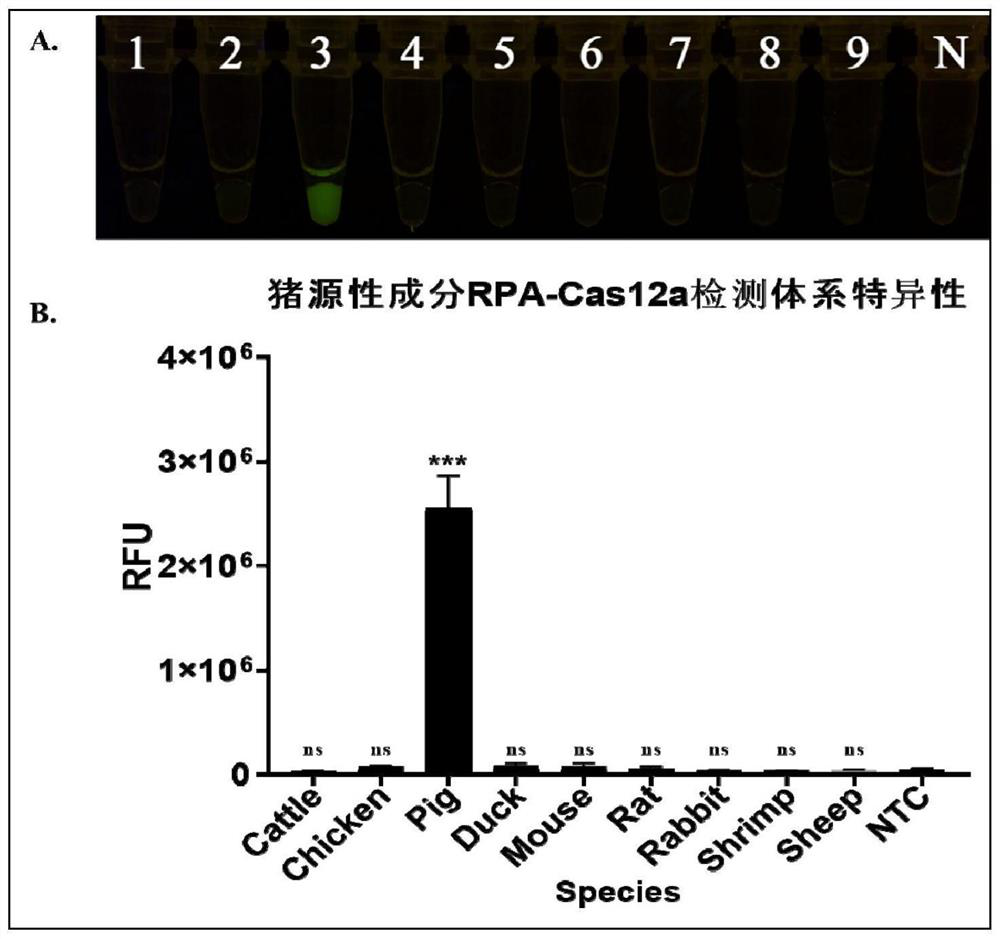RPA primer, detection system and method for identifying swine-derived components
A pig-derived, systematic technology, applied in biochemical equipment and methods, microbial determination/inspection, DNA/RNA fragments, etc., can solve the problem of insufficient accuracy and stability of test results, prone to false positives, not suitable for rapid Detection and other problems, to achieve the effect of rapid identification and detection, easy results, and lower detection costs
- Summary
- Abstract
- Description
- Claims
- Application Information
AI Technical Summary
Problems solved by technology
Method used
Image
Examples
Embodiment 1
[0057] The design of embodiment 1RPA primer and the optimization of reaction
[0058] 1. Design and screening of porcine-specific constant temperature amplification primers (RPA primers)
[0059] The present invention downloads the mitochondrial DNA sequences of 9 different breeds of pigs (Sus scrofa) and 9 different animal species from the GenBank database, and the information of the species involved is shown in Table 1. Using the Cluster W method in the MegAlign software, the homology comparison analysis of the mitochondrial DNA of 9 breeds of pigs was carried out, and the homology comparison analysis was also carried out with the mitochondrial DNA sequences of other 9 different animal species.
[0060] Table 1 Species information involved in RPA primer design
[0061]
[0062] On the basis of the comparative analysis results, a region that is conserved within the mitochondrial DNA of pig species and that differs greatly from the mitochondrial DNA sequences of other nine...
Embodiment 2
[0074] Example 2 Construction and optimization of the RPA-CRISPR / Cas12a detection system
[0075] The present invention obtains a highly specific crRNA probe for the amplified target gene by designing and screening the amplified target region of the RPA primer described in Example 1, the sequence of which is 5'-UAAUUUCUACUAAGUGUAGAUUUGGCCUGUGUGUAUAAAUA-3'( SEQ ID NO.3); at the same time, a fluorescently labeled ssDNA-reporter was designed with the sequence 5' FAM-TTTTTT-3'BHQ (SEQ ID NO.4), and the RPA-CRISPR / Cas12a detection system was constructed . The ssDNA-reporter has a FAM reporter group and a BHQ quencher group.
[0076] Using the purified amplified target product as a template, the crRNA concentration, Cas12a enzyme concentration, ssDNA-reporter concentration and reaction time in the CRISPR / Cas12a reaction system were optimized. The specific optimization conditions are shown in Table 3:
[0077] table 3
[0078]
[0079] By reacting under different conditions one b...
Embodiment 3
[0087] Example 3 The specificity verification of the RPA-CRISPR / Cas12a detection system
[0088] In order to verify the specificity of the RPA-CRISPR / Cas12a detection system constructed in the present invention, the present invention extracted the DNA of cattle, pigs, chickens, ducks, rats, mice, rabbits, prawns and sheep respectively as detection objects, and the constructed The specificity of the RPA-CRISPR / Cas12a detection system was verified. The DNA extraction, RPA-CRISPR / Cas12a detection system and reaction conditions were the same as those in Example 1, and the fluorescence value was measured at the end point by a real-time fluorescent PCR instrument. The specificity verification results of the RPA-CRISPR / Cas12a detection system are shown in Figure 2. It can be seen that the RPA-CRISPR / Cas12a detection system only produced obvious green fluorescence visible to the naked eye for pig DNA samples, but for the other 8 species such as cows and chickens. None of the species ...
PUM
 Login to View More
Login to View More Abstract
Description
Claims
Application Information
 Login to View More
Login to View More - R&D
- Intellectual Property
- Life Sciences
- Materials
- Tech Scout
- Unparalleled Data Quality
- Higher Quality Content
- 60% Fewer Hallucinations
Browse by: Latest US Patents, China's latest patents, Technical Efficacy Thesaurus, Application Domain, Technology Topic, Popular Technical Reports.
© 2025 PatSnap. All rights reserved.Legal|Privacy policy|Modern Slavery Act Transparency Statement|Sitemap|About US| Contact US: help@patsnap.com



